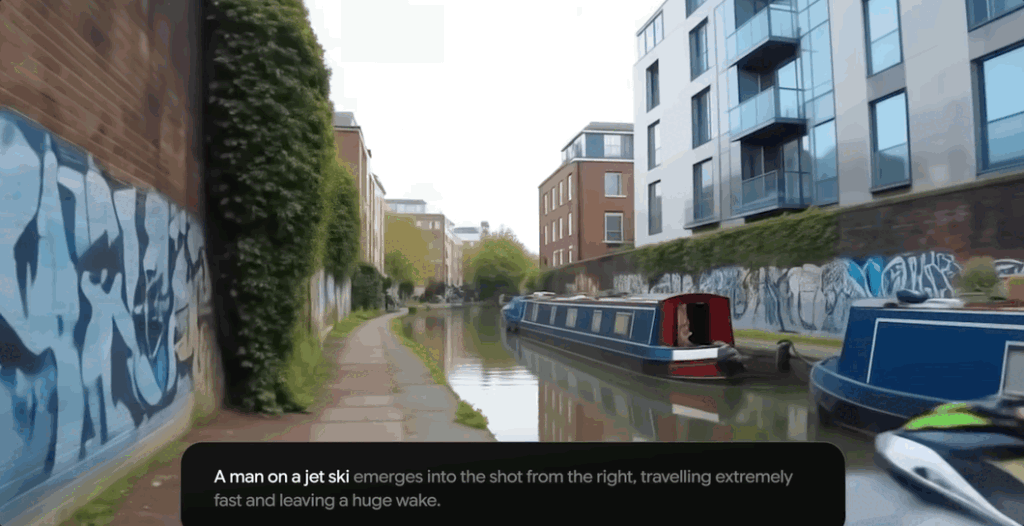


Google DeepMind has introduced a new AI tool called Genie 3. It is a powerful world model that can create interactive, real-time 3D environments using just a single line of text. This means you can simply type a prompt like “a rainy forest with wooden cabins,” and the AI will instantly create a full 3D scene where you can move around, interact with objects, and explore the environment in real time.
Genie 3 can render these scenes at 720p resolution and run them smoothly at 24 frames per second, giving users a realistic and immersive experience. Unlike traditional video games or animation tools, Genie 3 doesn’t rely on pre-programmed designs. Instead, it uses advanced machine learning to generate new, unique environments on the spot, based on the user’s prompt.
The model is trained on a large collection of video game data, visual environments, and agent behaviors. This training helps it understand how to build realistic scenes with proper lighting, shadows, movement, and object interaction. Whether it’s a desert, a forest, or a floating island in the sky, Genie 3 can turn your imagination into a walkable digital world.
One of the most impressive things about Genie 3 is that it is not limited to short clips or static frames. It creates long, continuous, and dynamic environments that maintain their look and feel for several minutes. Previous versions of Genie could only manage 10 to 20 seconds of consistency, but Genie 3 can keep scenes stable for much longer. It even remembers objects and layouts if you walk away and come back.
Another exciting feature is that the environment can change based on new instructions. For example, while exploring a mountain scene, you could say “add snowfall” or “make it night,” and the world will respond instantly. This ability to change the world mid-experience makes Genie 3 much more flexible and powerful.
The physical behavior inside the world also feels natural. If you throw an object, it moves realistically. If there’s water, it flows and reacts to touch. These responses are not programmed manually — they are learned by the model from real-world examples.
Currently, Genie 3 is being shared with selected researchers and creators in a limited preview. Google is taking a cautious approach to make sure the tool is used safely and ethically. There are still some technical limits, like the AI’s ability to handle text inside the 3D world, or managing multiple agents at once. But even with these early limitations, Genie 3 is a big step toward building AI systems that can understand and simulate full environments.
This tool is not just useful for gaming. It has potential in education, design, filmmaking, training, and storytelling. Imagine students learning history by walking through ancient cities, or filmmakers creating scenes by just describing them. The possibilities are endless.
Genie 3 marks a new era in AI — one where digital worlds can be created not in weeks or months, but in seconds, and with nothing more than imagination and a few words.
Genie 3 is not just a simple AI that shows images. It is a world-building model that creates 3D environments where you can move, look around, and interact. These are not just videos you watch, but places you can experience, like inside a video game.
The most powerful part of Genie 3 is that it works in real time. That means as soon as you give a prompt, the world is created and becomes active. You can start exploring immediately. For example, if you type “a city in the clouds,” Genie 3 will create tall buildings floating in the sky, with streets, lights, and moving clouds, and you can walk around it right away.
Another amazing thing about Genie 3 is its memory. In older models, if you placed an object somewhere and came back after a few seconds, it would be gone. But Genie 3 remembers. If you move a box and then walk away, it stays there when you return. This makes the world feel more stable and real.
It also understands how things behave. If you drop a ball, it falls naturally. If there’s water and you step into it, the surface reacts. These are not programmed by humans. Genie 3 learns these behaviors by watching a large number of real and simulated videos. That’s why it can show physical reactions like ripples, shadows, bouncing, or even weather effects like wind and rain.
One of the most exciting features is promptable world changes. This means you can change the environment while it’s running. For example, if you are walking through a desert and say “make it snow,” suddenly, the scene changes and snow starts falling. You don’t need to restart or reload. The world listens and responds in real time.
This feature opens up a huge number of creative possibilities. Teachers can build educational scenes. Game creators can test new levels. Designers can create room layouts. Even kids can describe a story and see it come to life instantly.
But Genie 3 is not perfect yet. It still has limits. For example:
- It cannot always show clear text or writing inside the 3D world.
- It sometimes makes small visual mistakes.
- It doesn’t fully understand complex instructions with many parts.
- It can only remember things for a short time — around a minute.
Even with these limits, Genie 3 is very far ahead compared to earlier AI models. It feels more like a “real world” than a video clip. It gives the user control to create, explore, and change environments — all through simple language.
Right now, Genie 3 is not available to the public. Google has shared it only with selected researchers and creators. They are testing it to see how it is used, what problems may come up, and how people respond to such power. They want to make sure it is developed responsibly.
Genie 3 also raises important questions. If AI can create whole worlds in seconds, what does that mean for artists and game designers? Will people prefer AI-made environments over real ones? Could this affect how children learn or how people interact with each other?
These questions are not just technical — they are about society, education, jobs, and creativity. That’s why tools like Genie 3 are being studied carefully before being given to everyone.
Still, Genie 3 is a big step forward. It shows that AI is not only about answering questions or making pictures. It can build worlds, tell stories, and react to people in real time.


